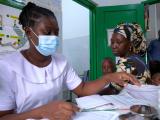Feb 21, 2011
Survey probes healthcare worker flu vaccine motivators
Flu vaccination requirements are very effective in boosting uptake in healthcare workers, and certain strategies such as offering the vaccine at work can also improve immunization rates, according to a survey commissioned by the US Centers for Disease Control and Prevention (CDC). The results of the online survey of 1,714 self-identified healthcare workers from a variety of settings was published online Feb 18 in Vaccine. The survey was conducted in June 2010 by Knowledge Networks, Inc. It asked about employees' exposure to workplace vaccination recommendations, requirements, and methods employers used to encourage uptake of seasonal and 2009 H1N1 vaccines. Two-thirds of healthcare workers reported they were offered worksite vaccination, and about half received reminders. About 10% of the respondents were subject to a vaccination requirement, either with or without penalties for noncompliance. Healthcare workers in hospital settings were more likely to have flu vaccination requirements, which strongly influenced vaccine update, regardless of a penalty for noncompliance. The investigators found that those offered the vaccine at work were almost 30% more likely to get the seasonal flu vaccine and 15% more likely to get the pandemic vaccine.
Feb 18 Vaccine report
Pandemic H1N1 VLP vaccine shown safe, immunogenic
Novavax's virus-like particle (VLP) 2009 H1N1 influenza vaccine was proven safe and effective in producing an immune response in early clinical trials, according to a company news release. Novavax, of Rockville, Md., presented its findings Feb 18 to the seventh World Health Organization (WHO) Meeting on Evaluation of Pandemic Influenza Vaccines in Clinical Trials. In a randomized, double-blind, placebo-controlled phase 2 trial, more than 3,000 volunteers received one dose of either 5, 15, or 45 micrograms (mcg) of antigen. The study found that one dose of the vaccine produced a strong immune response with few adverse events, even at the 5-mcg level. Current H1N1 vaccine doses are 15 mcg. The proportions of subjects who achieved a hemagglutinin inhibition titer of at least 1:40 (seroprotection) after 5-mcg, 15-mcg, and 45-mcg doses were 81.6%, 90.5%, and 91.6%, respectively. Day-14 seroconversion rates were 48.3%, 65.0%, and 74.9%, respectively, compared with 5.9% for the placebo group. A second vaccine dose administered 21 days after the first did not significantly change the seroprotection or seroconversion rates. VLP vaccines are produced in cells instead of in eggs and may speed up the manufacturing process.
Feb 18 Novavax press release
SLU, Chinese institute partner to find new malaria therapies
Drug-discovery scientists from Saint Louis University (SLU) and China's Guangzhou Institutes of Biomedicine and Health (GIBH) have formed a research partnership to develop new treatment s for malaria, according to a Feb 18 SLU press release. The key organizers from both institutions worked together in drug development for Pfizer Inc. Peter Ruminski, executive director of SLU's Center for World Health and Medicine, said in the statement that the alliance will help achieve the goal of developing new classes of drugs to treat malaria, which is increasingly becoming resistant to current treatments. "We think it is important for there to be multiple therapeutic options for treating malaria, as there are for HIV or for bacterial infections," he said.
Feb 18 Saint Louis University press release

















